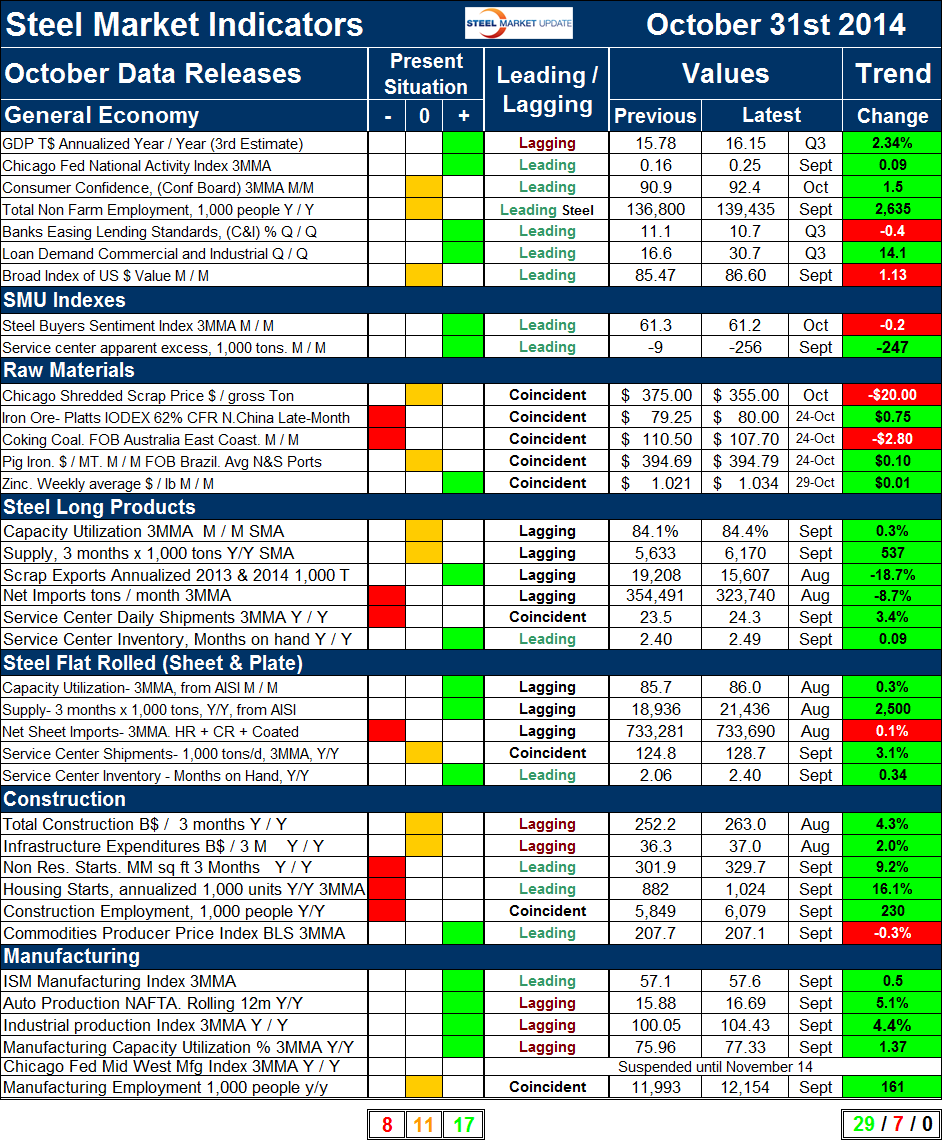SMU Data and Models

Key Market Indicators October 31st 2014
Written by Peter Wright
October 31, 2014
An explanation of the Key Indicators concept is given at the end of this piece for those readers who are unfamiliar with it.
The total number of indicators considered has been increased by one this month to thirty six. We have added the price of coking coal FOB the Australian East Coast to the raw materials section. The Chicago Fed Mid-West Manufacturing Index which was suspended earlier this year is expected to be re-instated next month after the staff complete a major re-vamp of the structure of their report.
Please refer to Table 1 for the view of the present situation and the quantitative measure of trends. Readers should regard the present situation column and color codes as a near instantaneous view of the current market condition. Seventeen of the present situation indicators based on historical standards were positive on October 31st and eight were negative with eleven considered to be close to the historical norm. This is a net increase of one positive and one negative and a net decrease of one neutral since the last publication one month ago. Details of changes to the present situation over the last month are as follows
The Broad Index of the US $ was re-classified from positive to neutral on the basis of recent strengthening. A strong dollar promotes imports and retards exports because overseas suppliers can obtain more for their product in their home currencies and US exports become more expensive abroad. There were no other changes in the General Economy section.
The SMU buyer’s sentiment index which was at an all-time high in September continued to be very strong with a three month moving average of 61.2. The buyer’s index is based on a survey of sheet producers and consumers and is not intended to be inclusive of long product market conditions. The service center excess was re-classified from neutral to positive. Service centers took in 256,000 tons less than they shipped in September up from a 9,000 ton deficit in August. We regard a large deficit as positive for prices going forward as it suggests that service center inventories are lean.
In the section “Raw materials” the price of Australian coking coal entered our analysis with a negative present situation based on the current subdued price. On October 24th the price stood at $107.70, we regard a price <$150 to be negative. There was a report in this morning’s press about the high profitability of China’s integrated steelmakers which in spite of lower domestic demand is being driven by the current price of coal and iron ore. Pig iron exports from Brazil have still not followed the downward trajectory of coal ore. The current price of zinc is considered to be positive. In all cases we regard high raw materials prices as good because such a situation indicates strength in the global market. One quick visual indicator in Table 1 is to compare the present situation of raw materials with that of the US flat rolled section lower in the table. Clearly the US market situation is stronger than the global market which promotes imports.
There were no changes in the present situation indicators of both the long and flat steel sections. Net imports continue to be high for both sectors. Capacity utilization apparent supply continue to be neutral for long products and positive for flat rolled.
There were no changes in the construction and manufacturing sections for the third straight month. Construction continues to be weak to neutral and manufacturing continues to be neutral to strong. Both nonresidential and residential construction starts are rated historically negative as is the total number of people employed in construction. The only indicator rated positive in the construction category is the producer price index of commodities which we believe to be highly correlated with industrial construction activity, particularly in the energy sector. None of the manufacturing indicators on a present situation basis are currently negative. Four are positive and one, manufacturing employment is neutral. The Chicago Fed Mid-West Manufacturing Index which was suspended early this year is expected to be re-instated in November.
This is the most optimistic review of the present situation since February 2010 when we first began this analysis.
The “Trend” columns of Table 1, also by their color codes are designed to give a quick visual appreciation of the direction in which the market is headed. However the quantitative analysis of the value and direction of each indicator over time are the latest “facts” available. There is nothing subjective about this section which is designed for those readers who want to dig deeper. The total number of positive trends in October increased by five to twenty nine which is also the best result since we began this analysis.
Changes in the individual sectors are described below. (Please note in most cases this is not October data but data that was released in October for previous months.)
In the general economy, GDP came in above expectations for Q3 in yesterday’s BEA report with a growth rate of 3.5 percent annualized. We expect revisions to be significant based on the erratic behavior of some of the components so stay tuned. In Table 1, GDP growth is reported as 2.34 percent which is the year / year rate and which we believe is more indicative of the real situation. The CFNAI which had declined in August reversed direction and expanded in September but with a value > zero this indicator has been signaling growth above the historical norm for the last seven months.
Trends in raw materials changed significantly in the latest data. Chicago shredded which had been unchanged in September dropped $20 in October and we expect a further significant drop in November. The price of scrap is responding to the price of iron ore and to the strengthening dollar. The price of iron ore recovered by 75 cents between September 19th and October 24th which reversed the previous negative trend. Coking coal entered this analysis with a negative trend by dropping by $2.80 in the 30 days prior to October 24th. The price of Brazilian pig iron continues to defy logic having shown no response to the declining price of its two primary ingredients. The average price of pig from Brazilian north and south ports has been stable for over two years. The price of zinc which had declined slightly in September picked up a cent to close at $1.034 on October 29th.
The trends of the two SMU proprietary indexes, reversed in October. The buyer’s sentiment which was at an all-time high in September had an insignificant decline from 61.3 in September to 61.2 in October. The service center deficit bounced back strongly from 9,000 tons to 256,000 tons.
In the long products section, all indicators trended positive for the third straight month in the data released in October. Capacity utilization improved and demand (as measured by apparent supply) increased at a rate in excess of two million tons / year. Net imports continued to decline but are still extremely high. Net imports of long products were zero in late 2011! Service center shipments increased for the sixth consecutive month but are still very depressed by historical standards.
In the flat rolled section capacity utilization which had declined at the second decimal place in July increased by 0.3 percent to 86.0 percent in August. Total supply, (domestic shipments + imports) increased for the fifth straight month. Net imports increased in August which is the latest month for which this data is available for the eighth straight month. Based on September licenses, imports of flat rolled continued to increase in September.
In the construction section there were no changes in the direction of trends, only one indicator, the price of commodities is trending negative. We regard this indicator as a driver of industrial construction which is still strong. Nonresidential and residential construction starts continue to improve but as we have reported elsewhere they both have a long way to go.
All trends in the manufacturing sector have been positive for six straight months. Industrial production index and auto production continue to expand at a 4.4 percent and 5.1 percent rate respectively. The three month moving average of ISM manufacturing index rose to 57.6 September, the highest level since May 2011.
The key indicators analysis is looking much better in its measure of the present situation and trends are very strong which bodes well for the balance of 2014. SMU has several benchmark analyses that show steel demand has recovered more slowly than the general economy and is still not where it should be at this stage of a recovery. This is because the recession in non residential and housing construction was so extreme. Steel supply is now beginning to close the gap as construction slowly picks up the pace.
We believe a continued examination of both the present situation and direction is a valuable tool for corporate business planning.
Explanation: The point of this analysis is to give both a quick visual appreciation of the market situation and a detailed description for those who want to dig deeper. It describes where we are now and the direction in which the market is headed and is designed to give a snapshot of the market on a specific date. The chart is stacked vertically to separate the primary indicators of the general economy, of proprietary Steel Market Update indices, of raw material prices, of both flat rolled and long product market indicators and finally of construction and manufacturing indicators. The indicators are classified as leading, coincident or lagging as shown in the third column.
Columns in the chart are designed to differentiate between where the market is today and the direction in which it is headed. It is quite possible for the present situation to be predominantly red and trends to be predominantly green and vice versa depending on the overall direction of the market. The present situation is sub-divided into, below the historical norm (-), (OK), and above the historical norm (+). The “Values” section of the chart is a quantitative definition of the market’s direction. In most cased values are three month moving averages to eliminate noise. In cases where seasonality is an issue, the evaluation of market direction is made on a year over year comparison to eliminate this effect. Where seasonality is not an issue concurrent periods are compared. The date of the latest data is identified in the third values column. Values will always be current as of the date of publication. Finally the far right column quantifies the trend as a percentage or numerical change with color code classification to indicate positive or negative direction.

Peter Wright
Read more from Peter WrightLatest in SMU Data and Models

SMU Steel Survey: Sentiment Indices dip as buyer optimism softens
SMU’s Buyers’ Sentiment Indices experienced multi-point declines this week, though both remain positive and continue to reflect optimism among steel buyers for their companies' ability to be successful.

SMU Scrap Survey: Current Buyers’ Sentiment flat, Future Sentiment tumbles
SMU's Current Scrap Buyers' Sentiment Index remained flat this month, while the Future Sentiment Index declined.

SMU Survey: Steel mill lead times show diverging trends
Buyers responding to our latest market survey reported that sheet lead times continue to gradually decline from recent highs. Meanwhile, plate lead times increased to levels last seen one year ago.

SMU Survey: Mills unlikely to budge on price, buyers say
Four out of every five steel buyers who responded to our latest market survey say domestic mills are unwilling to negotiate on new order spot pricing. Mills have shown little flexibility on pricing for nearly two months.

SMU’s March at a glance
SMU’s Monthly Review provides a summary of our key steel market metrics for the previous month, with the latest data updated through March 31.

